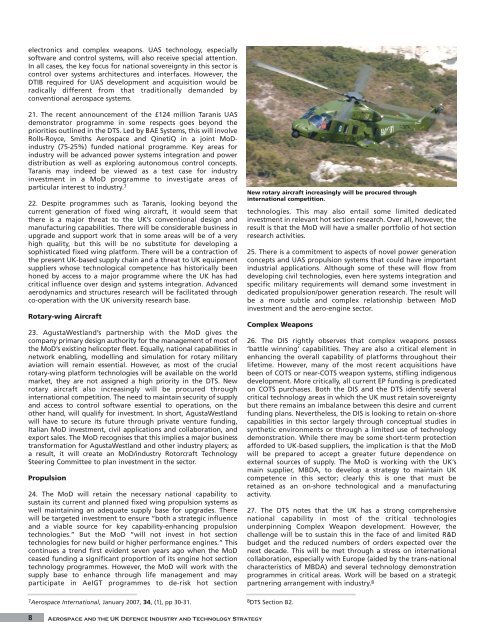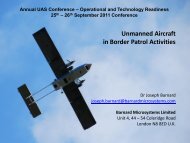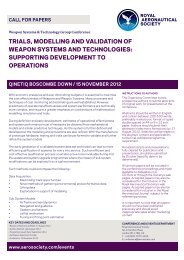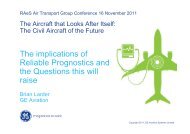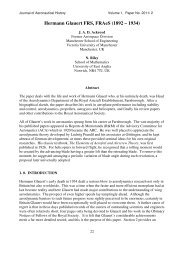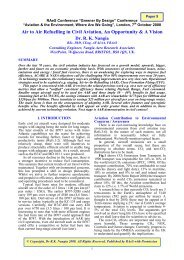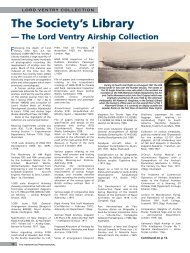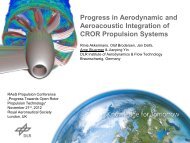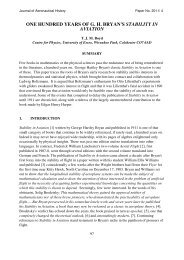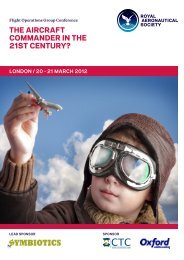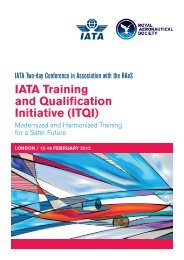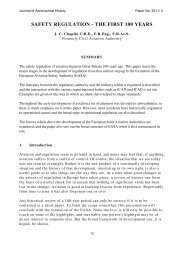DTS Paper.qxp - Royal Aeronautical Society
DTS Paper.qxp - Royal Aeronautical Society
DTS Paper.qxp - Royal Aeronautical Society
You also want an ePaper? Increase the reach of your titles
YUMPU automatically turns print PDFs into web optimized ePapers that Google loves.
electronics and complex weapons. UAS technology, especially<br />
software and control systems, will also receive special attention.<br />
In all cases, the key focus for national sovereignty in this sector is<br />
control over systems architectures and interfaces. However, the<br />
DTIB required for UAS development and acquisition would be<br />
radically different from that traditionally demanded by<br />
conventional aerospace systems.<br />
21. The recent announcement of the £124 million Taranis UAS<br />
demonstrator programme in some respects goes beyond the<br />
priorities outlined in the <strong>DTS</strong>. Led by BAE Systems, this will involve<br />
Rolls-Royce, Smiths Aerospace and QinetiQ in a joint MoDindustry<br />
(75-25%) funded national programme. Key areas for<br />
industry will be advanced power systems integration and power<br />
distribution as well as exploring autonomous control concepts.<br />
Taranis may indeed be viewed as a test case for industry<br />
investment in a MoD programme to investigate areas of<br />
particular interest to industry. 7<br />
22. Despite programmes such as Taranis, looking beyond the<br />
current generation of fixed wing aircraft, it would seem that<br />
there is a major threat to the UK’s conventional design and<br />
manufacturing capabilities. There will be considerable business in<br />
upgrade and support work that in some areas will be of a very<br />
high quality, but this will be no substitute for developing a<br />
sophisticated fixed wing platform. There will be a contraction of<br />
the present UK-based supply chain and a threat to UK equipment<br />
suppliers whose technological competence has historically been<br />
honed by access to a major programme where the UK has had<br />
critical influence over design and systems integration. Advanced<br />
aerodynamics and structures research will be facilitated through<br />
co-operation with the UK university research base.<br />
Rotary-wing Aircraft<br />
23. AgustaWestland’s partnership with the MoD gives the<br />
company primary design authority for the management of most of<br />
the MoD’s existing helicopter fleet. Equally, national capabilities in<br />
network enabling, modelling and simulation for rotary military<br />
aviation will remain essential. However, as most of the crucial<br />
rotary-wing platform technologies will be available on the world<br />
market, they are not assigned a high priority in the <strong>DTS</strong>. New<br />
rotary aircraft also increasingly will be procured through<br />
international competition. The need to maintain security of supply<br />
and access to control software essential to operations, on the<br />
other hand, will qualify for investment. In short, AgustaWestland<br />
will have to secure its future through private venture funding,<br />
Italian MoD investment, civil applications and collaboration, and<br />
export sales. The MoD recognises that this implies a major business<br />
transformation for AgustaWestland and other industry players; as<br />
a result, it will create an MoD/industry Rotorcraft Technology<br />
Steering Committee to plan investment in the sector.<br />
Propulsion<br />
24. The MoD will retain the necessary national capability to<br />
sustain its current and planned fixed wing propulsion systems as<br />
well maintaining an adequate supply base for upgrades. There<br />
will be targeted investment to ensure “both a strategic influence<br />
and a viable source for key capability-enhancing propulsion<br />
technologies.” But the MoD “will not invest in hot section<br />
technologies for new build or higher performance engines.” This<br />
continues a trend first evident seven years ago when the MoD<br />
ceased funding a significant proportion of its engine hot section<br />
technology programmes. However, the MoD will work with the<br />
supply base to enhance through life management and may<br />
participate in AeIGT programmes to de-risk hot section<br />
7 Aerospace International, January 2007, 34, (1), pp 30-31.<br />
8<br />
Aerospace and the UK Defence Industry and Technology Strategy<br />
New rotary aircraft increasingly will be procured through<br />
international competition.<br />
technologies. This may also entail some limited dedicated<br />
investment in relevant hot section research. Over all, however, the<br />
result is that the MoD will have a smaller portfolio of hot section<br />
research activities.<br />
25. There is a commitment to aspects of novel power generation<br />
concepts and UAS propulsion systems that could have important<br />
industrial applications. Although some of these will flow from<br />
developing civil technologies, even here systems integration and<br />
specific military requirements will demand some investment in<br />
dedicated propulsion/power generation research. The result will<br />
be a more subtle and complex relationship between MoD<br />
investment and the aero-engine sector.<br />
Complex Weapons<br />
26. The DIS rightly observes that complex weapons possess<br />
‘battle winning’ capabilities. They are also a critical element in<br />
enhancing the overall capability of platforms throughout their<br />
lifetime. However, many of the most recent acquisitions have<br />
been of COTS or near-COTS weapon systems, stifling indigenous<br />
development. More critically, all current EP funding is predicated<br />
on COTS purchases. Both the DIS and the <strong>DTS</strong> identify several<br />
critical technology areas in which the UK must retain sovereignty<br />
but there remains an imbalance between this desire and current<br />
funding plans. Nevertheless, the DIS is looking to retain on-shore<br />
capabilities in this sector largely through conceptual studies in<br />
synthetic environments or through a limited use of technology<br />
demonstration. While there may be some short-term protection<br />
afforded to UK-based suppliers, the implication is that the MoD<br />
will be prepared to accept a greater future dependence on<br />
external sources of supply. The MoD is working with the UK’s<br />
main supplier, MBDA, to develop a strategy to maintain UK<br />
competence in this sector; clearly this is one that must be<br />
retained as an on-shore technological and a manufacturing<br />
activity.<br />
27. The <strong>DTS</strong> notes that the UK has a strong comprehensive<br />
national capability in most of the critical technologies<br />
underpinning Complex Weapon development. However, the<br />
challenge will be to sustain this in the face of and limited R&D<br />
budget and the reduced numbers of orders expected over the<br />
next decade. This will be met through a stress on international<br />
collaboration, especially with Europe (aided by the trans-national<br />
characteristics of MBDA) and several technology demonstration<br />
programmes in critical areas. Work will be based on a strategic<br />
partnering arrangement with industry. 8<br />
8 <strong>DTS</strong> Section B2.


